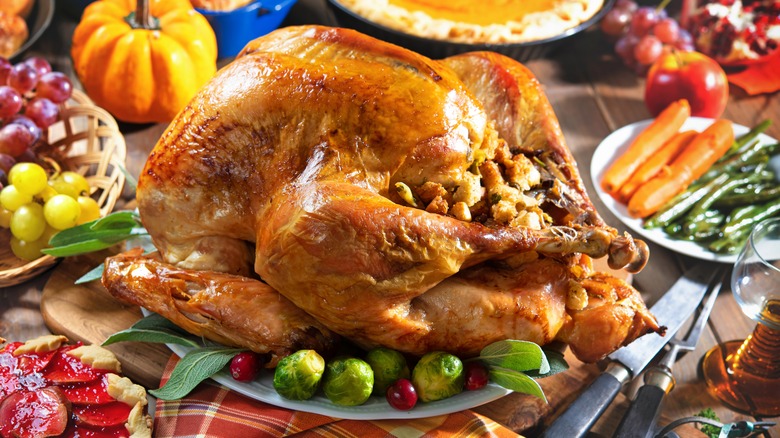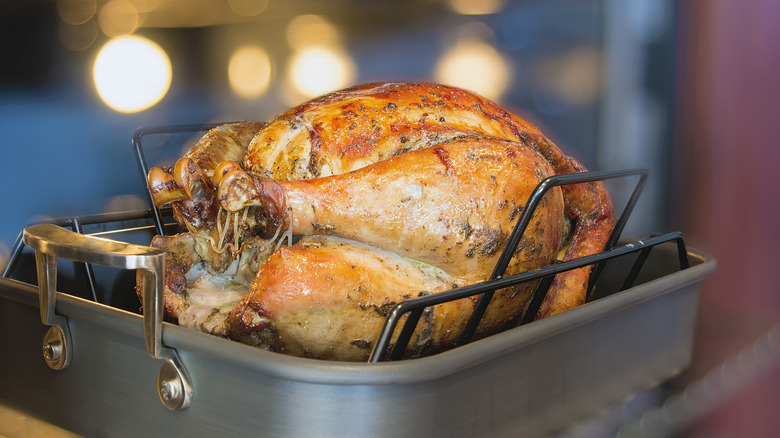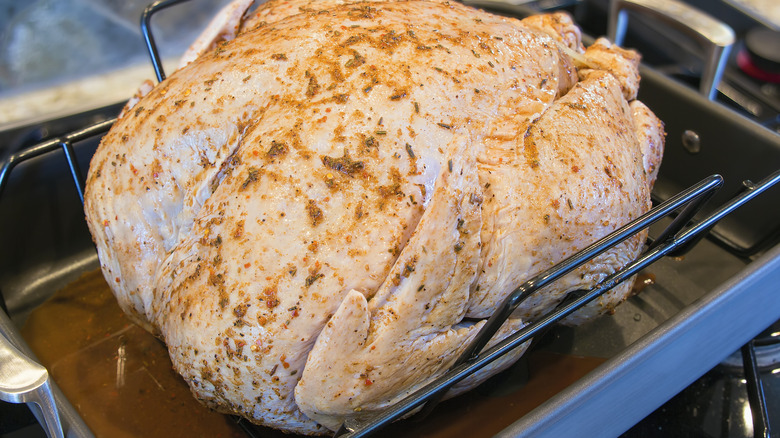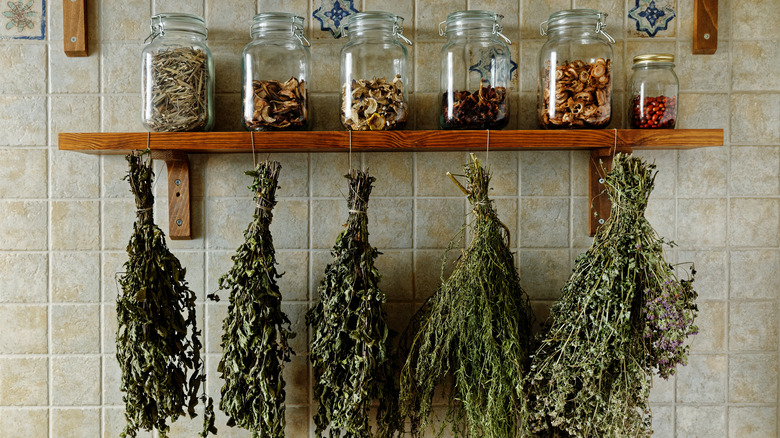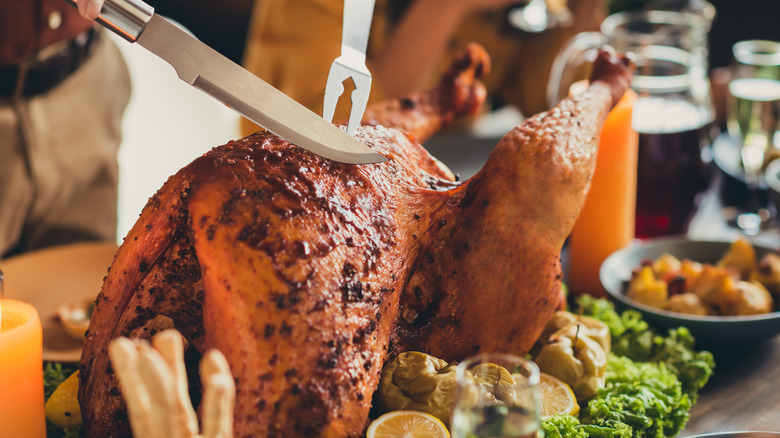Chef Tips For The Juiciest Thanksgiving Turkey
It's a classic Thanksgiving scene: A beautiful showpiece of a turkey graces the center of a Dwell-worthy tablescape, with its blistered golden skin glowing brightly like a first-place trophy. The sharpest of knives is drawn, the bird's aroma amping up the anticipation of that first bite. And, finally, when that bite happens ... wait, what the #%!&? It's stringy, flavorless, dry, and not even gravy can save it.
Many of us have fallen victim to the dry turkey plague. The cure: brining.
Not sure how? We asked the experts for tips and techniques on how to brine like a pro.
Brine basics
At the most basic level, brining refers to presalting protein before it gets cooked. Think pork shoulder, chicken legs, and even fish. Salt loves water, and when it's sprinkled onto the skin of these proteins, it draws out the water and then fills that empty space with salty brine. While the salt is creeping inward, it is simultaneously breaking down the meat, tenderizing and allowing it to retain moisture. When the poultry is cooked, proteins coagulate and prevent the absorbed liquid from escaping, ensuring juicy and flavorful meat. This is never more necessary than with a Thanksgiving bird.
Team Wet Brine vs. Team Dry Brine
There are two schools of brining, wet (where meat is submerged in a salty liquid) and dry (where meat is given a nice salt rub). Both produce a great bird, but chefs will go to the mat for their team. Wet brines make it easier to achieve juicy, tender meat and also allow for aromatic infusions, but dry brines give a crispier skin and more concentrated turkey flavor.
For a wet brine, dissolve salt in water, often with sugar, to create a well-seasoned liquid. Food science author Harold McGee suggests using a 5 percent salt solution (by weight) for an optimal job of tenderizing. That translates to roughly a scant three tablespoons of salt per one quart of water. Of course, this number slides up and down depending on how long the turkey sits in the brine. (Be warned: If a turkey sits in the brine for too long, it will turn into a salty and almost-mushy piece of meat.)
Houston's Underbelly chef Chris Shepherd is also a fan of the wet brine, explaining, "Brining is so important, because the interior muscle doesn't have salt or sugar to help it retain moisture, and brining flavors the bird." He follows a formula of 1 cup sugar + 1 cup salt + 5 gallons water + 3 days. Meanwhile, Stephanie Izard of Girl & the Goat in Chicago, uses a simple formula as well, which is equal parts water to turkey: A 10-pound turkey gets submerged overnight into a 10-pound brine (about 20 cups of water), with salt accounting for 3 percent (a scant half cup of salt) and sugar 2 percent (a scant half cup) of the total weight.
On the other end of the spectrum, dry brining also helps achieve juicy, flavorful meat and has the added bonus of not requiring a giant bucket to let your turkey brine away in. Chef Matt Lambert of The Musket Room in New York strongly supports dry brining his turkey, saying this method offers a more controlled flavor and ensures a better sear. He breaks the turkey down, then places the legs and breasts on a large tray lined with parchment paper and seasons the meat "reasonably heavy and lets it stand until the salt is completely dissolved, about one hour."
And don't forget about the gravy. In an interview with CNN's Eatocracy, McGee, who also leans toward team dry, points out that brining does give you a juicier turkey, but those pan juices end up being too salty for making good gravy. He says that to get a good turkey without wet brining, simply take the bird out of the refrigerator a couple of hours ahead to warm up and put ice packs on the breast area to keep it cold. That way the delicate breast meat will heat up slower than the tougher legs, avoiding overcooking.
Flavor: What aromatics do chefs recommend?
Brining isn't just about keeping turkey moist; it's also a time to infuse the meat with flavor. George Mendes of Lupulo submerges his turkey in a brine made with warm spices, like cinnamon and star anise, before basting with a Spanish paprika marinade and roasting it.
Shepherd replaces the traditional sugar in his wet brine with honey and also uses citrus, giving the savory turkey a floral aroma. Though in the past, Lambert has used preserved lemon and lime pickle to brine his turkey legs, nowadays, he prefers to never add sugar and keep it simple with thyme, rosemary and black pepper, avoiding the risk of too many flavor profiles fighting each other.
More turkey brine tips
Dry out wet-brined turkeys. After the turkey has soaked in the brine, rinse and let it dry. Thorough drying of the turkey ensures crispy, golden skin when the bird's roasted.
Be aware of cooking times. Brines are a curing method, and curing is a form of cooking. Brined turkeys cook faster than those that have not been brined.
Kosher turkeys have been presalted. Don't brine!
What the heck do you brine the turkey in? Izard offers great advice on this by using a large watercooler and turns the brine into an ice bath. "I do half of the water weight in ice, and the other half I use to boil with the sugar, salt and spices. Top it off with more ice and let the turkey hang in the cooler overnight." This saves some very valuable fridge space.
